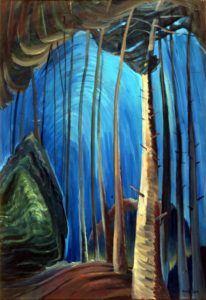A new exhibit at the Art Gallery of Greater Victoria (AGGV) is bringing the works of an artist who was overlooked in the early 20th century to the public’s attention once again.
Emily Carr was born in 1871 in Victoria; today she is well known for her intriguing landscapes and unique painting style. AGGV chief curator Michelle Jacques says there are reasons why Carr is still relevant.
“I think the two things that are evident immediately is that she loved the environment and landscape of this region, so many people who live here or visit are also really connected to it,” says Jacques. “So we really connect to her as somebody who appreciates the aesthetics and physicality of Vancouver Island.”
AGGV puts on many Carr exhibits, and Jacques has the challenge of coming up with new and refreshing ideas each time. The current exhibit, Unformable Things: Emily Carr and Some Canadian Modernists, looks at the work of Carr and some of her Canadian colleagues.
“We hope to help people realize how many ways there are to look at her work, so that we don’t get to the point where people feel like it’s not worth it to come back because they’ve already seen Emily Carr’s work,” says Jacques. “It’s an opportunity to look at her from a different angle and to help people realize how many ways there are to consider her work.”
Carr started off with Aboriginal imagery but ultimately found success when she focused her art more on landscapes, expressing the beauty of Vancouver Island.
“If you think about the context, not just the aesthetics, it helps you understand the way the world was historically,” says Jacques, “and it helps to understand change and evolution, and that just brings into focus the concerns that we have now.”
Today, it’s easy to view and buy images online instead of going to an art exhibit. But seeing a piece online is a very different experience than seeing it in person. Jacques says that the work of someone like Carr is a prime example of how important it is to see art in the flesh.
“She had a really unique approach to putting paint on her canvas or paper. You can really see the movement of the paint across the surface with her work, and imagine her making those marks,” she says. “In relation to the way she tries to convey her emotional response to the subject that she’s painting, you start to really imagine her in the forest making those marks on the canvas and you can see the detail in the flesh. It’s really hard to see that in a digital image.”
The reason Carr is still relevant today is because many people feel a certain connection to her as a person and an artist.
“She was really unique,” says Jacques. “She was a loner, and she lived a kind of alternative lifestyle for a woman of her era. So I think people really appreciate her as a person because she was a trailblazer as a woman artist in Canada.”
Unformable Things: Emily Carr and Some Canadian Modernists
Until Sunday, October 27
Art Gallery of Greater Victoria
aggv.ca

